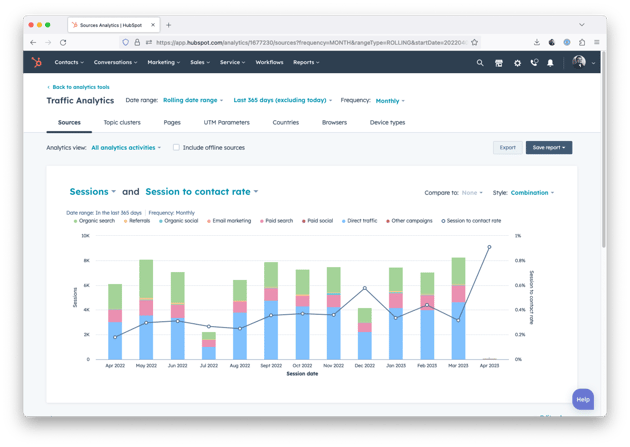How to Create & Manage Your Growth-Driven Design Wishlist
Think back to when your business last got a website redesign. While it's possible that you liked (mmmh, loved) the final product, you may not have necessarily enjoyed the process.
Did it cost you an arm and a leg? Perhaps there were considerable upfront costs too? Did it take longer to launch than anticipated? Or maybe you included features that you later found out were not needed?
But what if there was a quicker, smarter, more agile process that would only implement critical website features?
Fortunately, there is. If you've never heard a peep about it, it's called Growth-Driven Design, and at the heart of it is a high-action wishlist.
In this blog post, we tell what a growth-driven design wishlist is, how to set it up, and how to use it on an ongoing basis when optimizing your site.
Let's dive right in!

Growth-Driven Design Wishlist: An Overview
Before we strip down a growth-driven wishlist to its bare essentials, let's first start with explaining what GDD is.
The undisputed truth is that your website is the heart and soul of your marketing activities. Without it, you don't have a business—plain and simple.
You wouldn't let your marketing sit and gather dust. So why ignore your website for months or even years?
We're not telling you to redesign your site every few weeks. No.
We're talking about continuous improvement, and that's where GDD comes in.
GDD is a new agile approach to building, optimizing, and redesigning websites.
Rather than putting all your eggs in one basket, GDD allows you to develop and launch your site faster, better, and with fewer resources.
As part of Growth Driven-Design, the GDD wishlist is a list of elements you'd want your ideal website to have. These could be actions, features, or even design ideas—but they are things you envision in your "dream" website. Things that are absolutely critical to your site.
How To Set Up Your Growth-Driven Design Wishlist
So, you've carefully assessed your current web pages and decided which ones to keep, discard, and update. You've even identified your redesign goals and crafted a strategy for your website content. Now what?
Yup, time to set up a GDD wishlist.
When brainstorming your GDD wishlist, it's prudent to have a "clean slate" approach. Forget about issues with the existing site. Solely focus on what you would want the new system to incorporate, no matter the money and time constraints.
It's not a quick job, and you should spend at least a couple of hours with the team to write down your ideas. Not all of them are going to be implemented. In fact, most never will. Some ideas are for the launch pad, and some are for continuous improvement.
Every website strategy is unique, but even so, there are a few critical page elements you need to cover:
- Key, impactful website pages and sections
- Crucial design elements
- Marketing tools, resources, and assets
- Changes in experience based on country, devices, etc.
- Particular features, functionalities, and modules
How To Decide What To Focus On: The 80/20 Principle
Based on your design strategy, you'll need to analyze which of the elements on your wishlist are non-negotiable.
While many of the items will sound great and fun, they might not necessarily have the biggest impact on your ROI.
This is where the 80/20 rule comes in—helping you separate the chaff from the grain.
To apply this principle, bring together your entire team and try to identify the 20% of items that will yield 80% of the impact.
Once you've figured out the key 20%, pull them to one side. But the process doesn't end there. You need to conduct some extra filtering—you know, cut the meat to the bone.
With that in mind, ask the following questions for your growth-driven design wishlist:
- "Is this element 'nice to have' or a 'must-have'?" If the answer is "nice to have," then you need to return it to the main wishlist.
- "Is this element critical to the building of the launchpad site, or could we build it into the website later on?" If you agree with the second half of the question, return that element to the main wishlist.
The aim of the 80/20 analysis, and the filtering process as a whole, is to really narrow down on the core website elements. That way, you can get your website up and running as soon as possible.

Applying the Growth-Driven Design Wishlist to the Continuous Improvement of Your Site
Your wishlist is not a set-and-forget list. Consider keeping it. Why? Because it could be having plenty of features, elements, and ideas that might not be important at the moment but which could prove valuable in the long run as you continue to improve your site.
Again, your wishlist is not a list to add 1000s of ideas to without an actionable strategy for reviewing, cleaning, and adding on an ongoing basis.
Add to it when your team has fresh ideas, when you get client feedback, or when you need to execute a feature that has worked for your competitors.
As part of ongoing site management, you also need to ruthlessly clean things in your wishlist based on 80/20 thought gathering of user data, feedback, and general business changes.
Managing a wishlist is important to the success of a GDD-site. While that sounds easy, it may be difficult to stay on top of user data and elements that yield the biggest impact. The best way to stay on track is to use an ongoing review.
The aim of an ongoing review is to go through a cycle that primarily revolves around the persona that's visiting your site.
If you notice an item from the wishlist is no longer providing value, then re-assess and adjust your site as needed.
Your review should typically include four key stages:
- Plan—Take note of the action items that have the biggest impact on your long-term objectives. Do this by reviewing website performance, learning from the marketing & sales team, and continually brainstorming and prioritizing wishlist items.
- Develop—Implement high-priority/impactful wishlist items on the site. Then publish these new findings so that your whole team can view them.
- Learn—Assess past data about your visitors to know which changes worked and which didn't.
- Transfer—Pull together whatever you've learned from the current cycle and share them across your departments. This allows you and the entire company to find growth opportunities, better align with user preferences, and streamline the entire customer journey.
And once the review has been done, well, you'll need to do it all over again. Remember, the underlying principle of GDD is its dynamic, agile, iterative nature.
Wrapping Up
There's no doubt about it: GDD is quickly becoming the preferred choice for most website design/redesign projects, and at the heart of it is a growth design-driven wishlist. This tool can transform your site from just a launchpad to a well-oiled machine that not only attracts prospects but also dials up ROI—faster, better, and cheaper!





